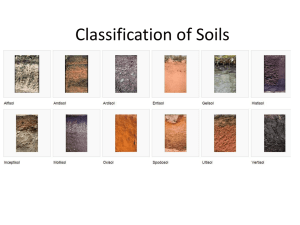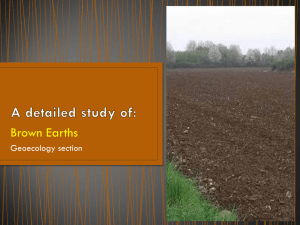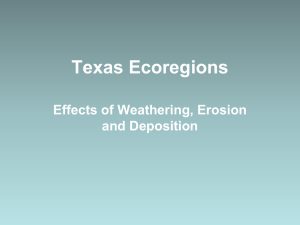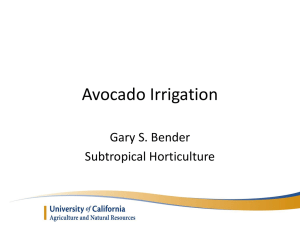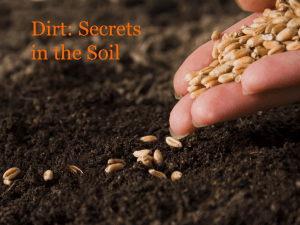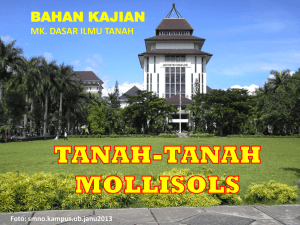Soil Orders 1
advertisement
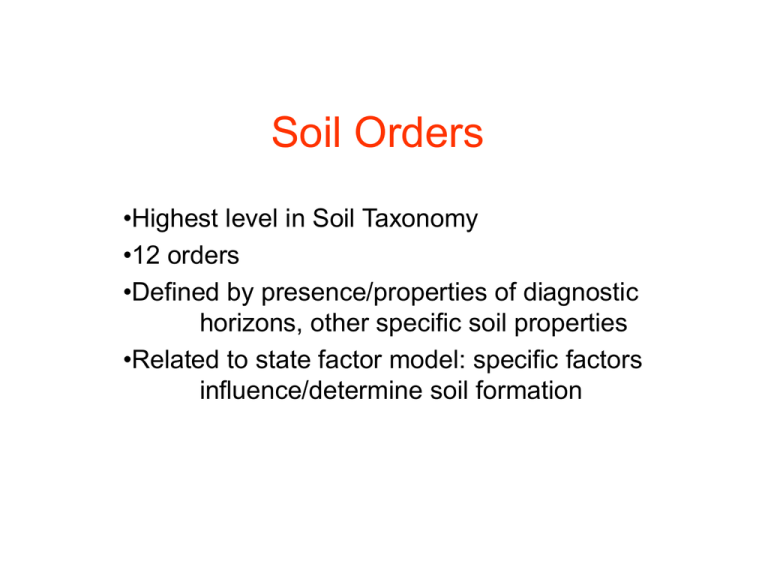
Soil Orders •Highest level in Soil Taxonomy •12 orders •Defined by presence/properties of diagnostic horizons, other specific soil properties •Related to state factor model: specific factors influence/determine soil formation Gelisols (-el) • Soils of very cold climates with permafrost – Permafrost within 1 m of surface – Gelic materials common above permafrost • Evidence of cryoturbation (soil mixing due to freeze/ thaw), ice wedges in profile – Suborders: • Histels (organic-rich) • Turbels (intense cryoturbation) • Orthels (other gelisols) Gelisol landscape with ice domes; tundra vegetation (above) Gelisol profile with permafrost at 85 cm (right) Mollisols (-oll) Mollisols • Soils developed under grassland vegetation with thick, dark colored surface horizons and high base saturation. • Requirements for classification of a soil as a Mollisol are: – Presence of a mollic epipedon, – Base saturation >50% in all horizons to 150 to 180 cm – Enough rainfall that the soil is not an Aridisol. Mollisol must be capable of producing crops without irrigation • Mollisols can have any subsurface diagnostic horizon • Genesis of Mollisols is that of mollic epipedon plus genesis of the subsurface diagnostic horizon present in the soil • Almost all Mollisols have mollic epipedons, but all soils with mollic epipedons are not Mollisols Mollisol Suborders • Albolls - albic horizon and characteristics of wetness. • Aquolls - aquic moisture regime (wet) • Rendolls – subsoil calcium carbonate inherited from parent material • Xerolls - xeric moisture regime; semi-arid climate with winter rain • Borolls - Mollisols with frigid or cryic temperature regime - cold Mollisols • Ustolls - ustic moisture regime; semi-arid climate with summer or equally distributed rain • Udolls - other Mollisols - udic moisture regime Mollisols – State Factor Considerations • The most important of the five factors is vegetation • Climate is of secondary importance – Mollisols are defined as being moist for three months during the year, i.e. enough rainfall for crop production – Climate must be such to produce sufficient biomass to form the mollic epipedon. • Parent material must contain enough base-rich primary minerals or basic cations for high base saturation. • Age of soil must be great enough for thick, dark surface to have developed (not very long) • Relief is not important Mollisols – Distribution • Mollisols are extensive in the Great Plains of the U.S., the Stepps of Russia, and Pampas of South America, and in other areas – All are associated with areas of native prairie. Mollisols – Distribution Mollisols – Problems and Use • Extensively used for agricultural production – High native fertility – Good water relationships – Easily tilled in most cases • Management problems similar to many of the other soil orders – – – – Wetness High clay content Salts These features designated at the lower levels of classification. • Not all Mollisols are productive soils – Many are shallow to rock or have other limitations Mollisols – Problems and Use Alfisols (-alf) • Central concept is soils that have an ochric epipedon, an argillic or kandic horizon, and moderate to high base saturation. • Most Alfisols have developed under forest vegetation • Three prerequisites are met by Alfisol landscapes: – The parent material and resulting soil have a moderate abundance of layer-lattice clay or the parent material had sufficient weatherable minerals to form moderate to high amounts of clay – The landscape has been stable enough and the soil is old enough for formation of an argillic horizon. – The soils retain significant amounts of primary minerals as potential plant nutrient reserves. Alfisols • Alfisols are defined as having more than 35% base saturation in lower subsoil horizons – Implications in terms of plant nutrition, i.e. P fixation, Al toxicity, etc. • Because the property common to Alfisols is the presence of an argillic horizon, the only common thread in their genesis is the presence of clays and weatherable minerals in the parent material and enough landscape stability to form the argillic. • Other factors are widely variable (climate, parent material, organics) State Factor Considerations • Time, parent material, climate, relief, and vegetation have all shown their effects on Alfisol genesis. • Time - enough time for clay translocation and textural differentiation to occur (thousands of years), but not enough to completely leach bases (base saturation >35%). • Parent material – Had supply of weatherable primary minerals to supply basic cations (high base saturation) – Enough clays that translocation and textural differentiation have occurred. • Relief - landscape has been stable for enough for effects of climate, vegetation, and time to show their effects on soil development. • Vegetation – Primarily forest in humid climates – May be grass in semi-arid and arid climates • Climate – Sufficient water movement to translocate clays – Included periods of seasonal moisture deficit. Problems and Use • Used extensively in midwest U.S. and other parts of the world for agronomic crop production • Because of the wide range in properties, problems with soil use must be interpreted at lower levels of classification. Distribution Distribution Ultisols (-ult) • Concept: soil that have an argillic or kandic horizon with low base saturation • There is more precipitation than evapotranspiration during some season • Other season - water moves through the soils • Release of bases by weathering is less than to removal by leaching – Bases have been leached from the parent material or – The parent material did not contain large amounts of basic cations • Most of the bases commonly are held in the vegetation and the upper few centimeters – Base saturation commonly decreases with increasing depth because the vegetation has concentrated the bases in the upper part of the soil • Cultivation is a shifting cultivation unless soil amendments are applied – Slash & burn – exploit bases concentrated near the surface by vegetation Ultisols • Most extensive in warm, humid climates that have a seasonal deficit of precipitation • Mainly on Pleistocene or older surfaces • Formed in a very wide variety of parent materials – Parent materials have few primary minerals that contain bases other than micas • Clay mineralogy – Kaolinite, gibbsite, and aluminum-interlayered clays are most common – Smectite may be present if it was in the parent materials • Extractable aluminum normally is high • A calcium-deficient argillic horizon is common in the Ultisols in the United States Ultisols • Most Ultisols in the U.S. had a vegetation of coniferous or hardwood forests at the time of settlement – In other parts of the world, vegetation may be a savanna, but they may be anthropic. • Ultisols have been considered to be intermediate in the development sequence between Alfisols and Oxisols – Parent material and climate are also important factors in the development of Ultisols • Argillic horizon is evidence for climate with periods of moisture deficit • Base saturation <35% in lower subsoil horizons implies potential Al toxicity and may have high P fixation • Significance in terms of landscape and clay or weatherable minerals in the parent material is the same as that for Alfisols Ultisols • State factor considerations: – Similar to Alfisol factors – Time may be more important for Ultisols than for Alfisols to achieve advanced stages of weathering. – Parent material and warm climates can lead to Ultisol development in the same time frame that Alfisols develop. • Problems and use: – In U.S., historically important as cotton soils – Timber and pulp important crops at present – Ultisols are important worldwide for agricultural production • With fertility additions and proper management, Ultisols can be quite productive. • Many regions of the world do not have large areas of Mollisols and Alfisols. Ultisols may be the best available Ultisol Distribution Ultisol Distribution Oxisols (-ox) • Sesquioxide-rich, highly-weathered soils of the tropics. • Oxisols commonly have diffuse boundaries because of long period of water movement through the soil • Oxisols – have an oxic horizon within 150 cm of the surface and do not have the clay increase for a kandic horizon or – have 40% or more clay in the surface and, within 150 cm have an oxic horizon or a kandic horizon that meets the weatherable mineral requirements of an oxic horizon and – do not have a spodic horizon. • Have been referred to as laterites or ground-water laterites in the past. • All tropical soils are not Oxisols – About 98% of all Oxisols are found in the tropics, but – About 23% of the tropics are Oxisols – About 70% of the Ultisols occur in tropical climates Oxisols Conditions for Formation • Stable land surface • Humid tropical climate or – Drier climate with a monsoonal climate • Basic parent material, i.e. high in weatherable minerals or – Parent materials that have gone through soil development one or more times • Great soil age or great age of previously weathered parent materials State Factor Considerations • • Time and parent material are the two most important factors Climate influences Oxisol formation, but is not as important as is often thought – Oxisol occurrence in tropics suggests influence of temperature and high rainfall – Many tropical landscapes are more stable and older than temperate landscapes • • • No glaciation and little uplift or other tectonic activity that would renew the landscape Oxisols must be on stable landscapes or erosion and deposition would destroy and/or rejuvenate the soil Oxisols are commonly associated with parent materials that either – are high in minerals with large amounts of basic cations • Weather rapidly and large amount of Fe released to form oxides – have gone through one or more weathering cycles before the current soil development stage • • soil formed, eroded and deposited, and soil development recommenced in previously weathered material • Erosion and deposition will not introduce weatherable minerals Most Oxisols form under forests but savannah vegetation is common Oxisols • Suborders: – – – – – Aquox - aquic moisture regime Torrox - aridic moisture regime Ustox - ustic moisture regime (probably most extensive suborder) Perox - perudic moisture regime Udox - udic moisture regime • Problems and use: – low native fertility and CEC • most plant nutrients present in organic forms near the soil surface – Slash and burn agriculture – P fixation is often high • High contents of Fe and Al oxides – Water relations are not always good • High hydraulic conductivity and low water holding capacity • Oxisols can be highly productive soils with proper management Typic Acrudox - Philippines Depth cm Ap AB Bo1 Bo2 Bo3 Bo4 Bo5 Bo6 012 29 52 79 104 140 178 - CEC/ P ts silt Clay Fe pH OC CEC BS clay Ret 12 3.7 18.4 29 2.6 16.9 52 2.6 19.9 79 2.6 18.8 104 3.0 21.1 140 3.8 22.0 178 2.0 16.6 195 1.9 17.4 77.9 80.5 77.4 78.6 75.9 74.2 81.3 80.6 6.5 6.6 8.8 8.8 8.4 8.6 8.9 8.3 5.6 5.4 5.7 5.7 5.7 5.7 5.6 5.6 2.12 14.6 1.42 11.8 0.94 9.8 0.50 8.5 0.37 8.1 0.34 7.8 0.25 7.5 0.20 8.0 15 15 17 6 7 13 13 8 19 15 13 11 11 11 9 10 73 78 81 77 84 85 85 86 Oxisols Entisols (-ent) • Mineral soils with little or no evidence of development of pedogenic horizons. • Defined as soils without any diagnostic horizon except an ochric epipedon – In general, they lack any genetic horizon, i.e. A horizon over C horizons – May have a B horizon (Bw, Bk) that does not meet diagnostic horizon criteria Entisols • Lack of genetic horizons may be because of – – – – – – – – – – short time since deposition of parent material dry climates that limit water movement mass wasting and other forms of erosion (time) accretion of recent deposits (time) immobilization of mobile soil constituents resistance to weathering by mineral components toxicity of initial parent material to plant growth drastic change in biotic soil forming factor saturation with water for long periods man Entisols Entisols - Man Distribution • Found in any climate under any vegetation • Most extensive soil order – Occupy about 16% of earth's surface. • Often associated with rapid deposition in floodplains • 60% of Entisols occur in desert regions – Lack of rainfall prevents diagnostic horizon formation • Other common environments – – – – mountainous regions actively accreting footslopes swamps and marshes mined areas and other areas of human disturbance Distribution Distribution Entisols Suborders • Aquents - permanently or seasonally wet Entisols • Arents - have fragments of diagnostic horizons – Soils that have been disturbed • Deep plowing and land leveling • Mine spoils are commonly not Arents – no identifiable fragments of diagnostic horizons. • Psamments - sandy Entisols • Fluvents - Alluvial soils that have an irregular distribution of organic C. • Orthents - loamy and clayey soils with regular distribution of organic C – actively eroding areas and deserts – Mine spoils State Factors • No pedogenic development – Factors that have prevented development • Time – Active erosion or deposition • Climate – deserts • Parent material – resistant parent material – Quartz sand parent material will remain as quartz sand C horizon • Biology – man • Relief – Steep slopes – Low wet areas Problems and Use • Few statements can be made because of the variable reasons for the occurrence of Entisols. • Entisols on steep slopes may be erosive and subject to landslides. • Hydraquents and Sulfaquents (common in salt marshes) – low bearing capacity – Sulfaquents form sulfuric horizons (extremely low pH) when drained. • Psamments – Low available water, low native fertility, subject to wind erosion – If irrigated, often used for root and tuber crops and for crops that wet soils might damage • Many Orthents used for forestry, pasture, range, and wildlife areas. • Fluvents are often used for parks and other recreational areas • Many Entisols are highly agriculturally productive, e.g. the Nile River Valley • Man has always had a close association with Entisols because of their common occurrence in coastal areas and in river bottoms. Inceptisols • • Central concept: a broad group of slightly to moderately developed mineral soils. Inceptisols are difficult to define because they are "in-between" soils in terms of development. – Have to have acquired a diagnostic horizon (cambic, calcic, sulfuric, mollic, umbric, etc.) to be different from Entisols – Cannot have diagnostic horizons that require considerable time or special circumstances to form (argillic, kandic, spodic, oxic). – Do not have special characteristics that would result in their placement into Mollisols, Andisols, Vertisols, Aridisols, etc. • Inceptisols are not allowed to have an aridic or torric moisture regime – Few Inceptisols are found in desert regions. • Because of the diversity of Inceptisols, few statements can be made in terms of their genesis. – Common on • steeply sloping, mountainous landscapes • recent alluvial deposits • Large areas of Inceptisols are found in the Applachian Mountains, Andes, Rocky Mountains, Mississippi River valley, Amazon River valley, and similar areas State Factor Considerations • Relief is an overriding factor in many cases – Steep slopes • rate of erosion and rate of soil development about equal – Depositional landscapes • Rate of deposition or • Time since the last major deposition • • • • Time since end of erosion or deposition Resistant parent material? Vegetation has little, if any, affect Climate may limit rate of development – Cannot have aridic moisture regime Distribution Distribution Inceptisols • Problems and use: – generally on steeper slopes than soils in other orders and are more subject to erosion. – few general statements can be made about the use or management – Inceptisols in alluvial areas are often very fertile and used extensively for crop production Inceptisols
